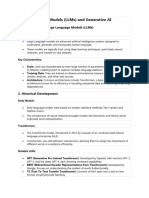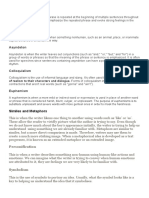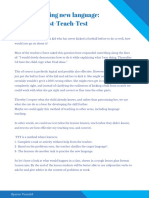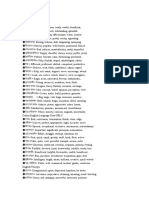JioDiscover-What is the neural networ
Uploaded by
Arvind TiwariJioDiscover-What is the neural networ
Uploaded by
Arvind TiwariWhat is the neural network like
transformed in LLM?
Transformer Architecture: A Key Component of Large Language Models
The Transformer architecture is a crucial component of Large Language
Models (LLMs), which are used for natural language processing and
generation tasks. Introduced in the paper "Attention is All You Need" by
Vaswani et al. in 2017, the Transformer architecture revolutionized the field of
NLP by providing a more efficient and effective way to process and generate
sequences of data.
Key Components of the Transformer Architecture
The Transformer architecture consists of several key components, including:
1. Embedding Layer: This layer converts input tokens (words or subwords) into
numerical vectors, which are used as input to the model.
2. Positional Encoding: This layer adds information about the position of each
token in the sequence to its embedding.
3. Encoder: The encoder processes the input sequence and extracts
contextual information.
4. Decoder: The decoder generates coherent responses by predicting the
next words in a sequence.
5. Self-Attention Mechanism: This mechanism allows the model to focus on
different parts of the input sequence simultaneously, capturing contextual
information and relationships between words.
6. Feed-Forward Neural Networks: These networks apply non-linear
transformations to the data, allowing the model to learn complex patterns
and relationships.
How Transformers Work
Transformers work by processing the input sequence through multiple layers
of the encoder and decoder. The self-attention mechanism allows the model
to focus on different parts of the input sequence simultaneously, capturing
contextual information and relationships between words. The output of the
encoder is then passed through the decoder, which generates coherent
responses by predicting the next words in a sequence.
Advantages of Transformers
Transformers have several advantages over traditional recurrent neural
networks (RNNs), including:
1. Parallel Processing: Transformers can process data in parallel, making
them faster and more efficient than RNNs.
2. Handling Long-range Dependencies: The self-attention mechanism allows
Transformers to handle dependencies irrespective of the distance between
elements.
3. Scalability: The Transformer architecture is highly scalable, leading to the
development of models with billions of parameters.
Conclusion
The Transformer architecture is a key component of Large Language Models,
which are used for natural language processing and generation tasks. Its
ability to process data in parallel and handle long-range dependencies
makes it a more efficient and effective way to process and generate
sequences of data. Understanding the Transformer architecture is crucial for
anyone looking to implement Large Language Models in their applications.
The current transformer architecture is a powerful tool for handling
sequence data, and its applications range from machine translation to text
summarization. To further enhance its capabilities, researchers are working
on techniques to improve the efficiency and robustness of the transformer
architecture.
The attention mechanism, a key component of the transformer architecture,
allows the model to focus on specific parts of the input data, similar to how
humans pay attention to specific parts of a sentence while comprehending
or responding. This mechanism computes a weighted sum of input values,
where the weights are decided based on the query, key, and value
representations of the data.
The transformer architecture, coupled with the attention mechanism, stands
as one of the most pivotal advancements in NLP. It's the bedrock on which
giants like GPT-3 and BERT stand. Grasping its mechanics is key to
understanding the nuances of these LLMs.
In the next post, we'll delve into the intricacies of training these behemoths,
exploring challenges and techniques that ensure their proficiency. Until then,
revel in the transformative power of Transformers!
Conclusion
Transformers have revolutionized the field of natural language processing
(NLP) by providing a more efficient and effective way to process and
generate sequences of data. Their ability to handle long-range
dependencies and parallel processing makes them a powerful tool for
various applications. Understanding the Transformer architecture is crucial
for anyone looking to implement Large Language Models in their
applications.
Images
Sources
• Transformer Neural Networks: A Step-by-Step Breakdown | Built In
https://builtin.com/artificial-intelligence/transformer-neural-network
• From Words to Vectors: Inside the LLM Transformer Architecture | by Harika Panuganty |
Medium
https://medium.com/@harikapanuganty/from-words-to-vectors-inside-the-llm-transformer-
architecture-50275c354bc4
• Understanding the Transformer Architecture in LLM | by Asad Ali | Medium
https://medium.com/@asadali.syne/understanding-the-transformer-architecture-in-llm-
e475453879fe
• Large Language Models (LLMs) vs Transformers - GeeksforGeeks
https://www.geeksforgeeks.org/large-language-models-llms-vs-transformers/
• Transformer Explainer: LLM Transformer Model Visually Explained
https://poloclub.github.io/transformer-explainer/
• Understanding Transformers & the Architecture of LLMs
https://blog.mlq.ai/llm-transformer-architecture/
• Understanding LLM Transformers: The Future of Natural Language Processing and AI | Large
Language Models AI
https://largelanguagemodels-ai.com/blog/llm-transformer
• LLM Architectures Explained: Transformers (Part 6) | by Vipra Singh | Medium
https://medium.com/@vipra_singh/llm-architectures-explained-understanding-transformers-
part-6-3a5573ed30e7
• Transformers and Attention Mechanism: The Backbone of LLMs — Blog 3/10 Large Language
Model Blog Series By AceTheCloud | by Abhishek Gupta | AceTheCloud
https://blog.acethecloud.com/transformers-and-attention-mechanism-the-backbone-of-llms-
blog-3-10-bfba00fcded6
Videos
• From Neural Networks to Large Language Models (LLMs)
https://www.youtube.com/watch?v=4M-gX9KZkj4
• But what is a neural network? | Deep learning chapter 1
https://www.youtube.com/watch?v=aircAruvnKk&vl=en
• Transformer Neural Networks, ChatGPT's foundation, Clearly ...
https://www.youtube.com/watch?v=zxQyTK8quyY
• The Neural Network, A Visual Introduction
https://www.youtube.com/watch?v=UOvPeC8WOt8
• Transformers (how LLMs work) explained visually | DL5
https://www.youtube.com/watch?v=wjZofJX0v4M&vl=en
• Lecture 5: Neural Networks
https://www.youtube.com/watch?v=g6InpdhUblE
You might also like
- Whitepaper - Foundational Large Language Models & Text Generation100% (1)Whitepaper - Foundational Large Language Models & Text Generation75 pages
- Nicole Koenigstein - Transformers in Action (MEAP v7) 2024 (2024, Manning Publications Co.) - Libgen.liNo ratings yetNicole Koenigstein - Transformers in Action (MEAP v7) 2024 (2024, Manning Publications Co.) - Libgen.li272 pages
- Sinan Ozdemir - Quick Start Guide to Large Language Models, Second Edition-Addison-Wesley (2024)No ratings yetSinan Ozdemir - Quick Start Guide to Large Language Models, Second Edition-Addison-Wesley (2024)279 pages
- How Transformers Work_ A Detailed Exploration of Transformer Architecture _ DataCampNo ratings yetHow Transformers Work_ A Detailed Exploration of Transformer Architecture _ DataCamp19 pages
- The Transformer Revolution Unveiling The Inner Workings of A Computational MarvelNo ratings yetThe Transformer Revolution Unveiling The Inner Workings of A Computational Marvel2 pages
- DeployingandEnhancingAIModels-ADeepDiveintoPortableandTrainableTransformerArchitecturesNo ratings yetDeployingandEnhancingAIModels-ADeepDiveintoPortableandTrainableTransformerArchitectures26 pages
- Hugging Face Transformers Essentials: From Fine-Tuning to DeploymentFrom EverandHugging Face Transformers Essentials: From Fine-Tuning to DeploymentNo ratings yet
- Generative AI For Everyone: Doç. Dr. Murat Mühendislik Fakültesi, Bilgisayar, Gazi Üniversitesi, E-Mail: My Gazi - Edu.trNo ratings yetGenerative AI For Everyone: Doç. Dr. Murat Mühendislik Fakültesi, Bilgisayar, Gazi Üniversitesi, E-Mail: My Gazi - Edu.tr44 pages
- Generative AI Interview Questions and AnswersNo ratings yetGenerative AI Interview Questions and Answers7 pages
- [FREE PDF SAMPLE] Transformers in Action MEAP V06 Nicole Koenigstein ebook full chapters100% (2)[FREE PDF SAMPLE] Transformers in Action MEAP V06 Nicole Koenigstein ebook full chapters58 pages
- Transformers in Action MEAP V06 Nicole Koenigstein - Instantly access the full ebook content in just a few seconds100% (1)Transformers in Action MEAP V06 Nicole Koenigstein - Instantly access the full ebook content in just a few seconds47 pages
- LLM .Foundation - Models.from - The.ground - UpNo ratings yetLLM .Foundation - Models.from - The.ground - Up195 pages
- Natural Language Processing With Deep Learning CS224N/Ling284No ratings yetNatural Language Processing With Deep Learning CS224N/Ling28462 pages
- Transformer Architectures_ResearchPaper (1)No ratings yetTransformer Architectures_ResearchPaper (1)13 pages
- Pieces DZ RC 393 Getting Started Llms 2024No ratings yetPieces DZ RC 393 Getting Started Llms 20248 pages
- 2022-markowitz-Transformers, Explained_ Understand the Model Behind GPT-3, BERT, and T5No ratings yet2022-markowitz-Transformers, Explained_ Understand the Model Behind GPT-3, BERT, and T511 pages
- Whitepaper_Foundational Large Language Models & Text Generation_v2100% (1)Whitepaper_Foundational Large Language Models & Text Generation_v286 pages
- Unlocking_the_potential_A_comprehensive_exploratioNo ratings yetUnlocking_the_potential_A_comprehensive_exploratio6 pages
- Transformer Architecture explained in LLMsNo ratings yetTransformer Architecture explained in LLMs2 pages
- Advancing Transformer Architecture in Long-Context Large Language Models: A Comprehensive SurveyNo ratings yetAdvancing Transformer Architecture in Long-Context Large Language Models: A Comprehensive Survey40 pages
- Building Transformer Models with PyTorch 2.0: NLP, computer vision, and speech processing with PyTorch and Hugging Face (English Edition)From EverandBuilding Transformer Models with PyTorch 2.0: NLP, computer vision, and speech processing with PyTorch and Hugging Face (English Edition)No ratings yet
- Conditional Sentences: Mixed Types: Put The Verbs in Brackets Into The Correct TensesNo ratings yetConditional Sentences: Mixed Types: Put The Verbs in Brackets Into The Correct Tenses2 pages
- (Ebook) The Sociolinguistics of Iran’s Languages at Home and Abroad: The Case of Persian, Azerbaijani, and Kurdish by Seyed Hadi Mirvahedi ISBN 9783030196042, 9783030196059, 3030196046, 3030196054 all chapter instant download100% (7)(Ebook) The Sociolinguistics of Iran’s Languages at Home and Abroad: The Case of Persian, Azerbaijani, and Kurdish by Seyed Hadi Mirvahedi ISBN 9783030196042, 9783030196059, 3030196046, 3030196054 all chapter instant download65 pages
- A History of the English Language 2d ed Edition Michael D. C. Drout - Quickly access the ebook and start reading todayNo ratings yetA History of the English Language 2d ed Edition Michael D. C. Drout - Quickly access the ebook and start reading today47 pages
- Aloud Strategy To Improve Students' ReadingNo ratings yetAloud Strategy To Improve Students' Reading163 pages
- Indian Education Society Icse: Mental Math Project: Ch. 11. Data HandlingNo ratings yetIndian Education Society Icse: Mental Math Project: Ch. 11. Data Handling2 pages
- Clarifying New Language: Test-Teach-Test: Bjarne VonsildNo ratings yetClarifying New Language: Test-Teach-Test: Bjarne Vonsild7 pages
- Full-Paper-DEVELOPING-EFL-LEARNERS’-LISTENING-COMPREHENSION-THROUGH-CALL-FACILITIESNo ratings yetFull-Paper-DEVELOPING-EFL-LEARNERS’-LISTENING-COMPREHENSION-THROUGH-CALL-FACILITIES8 pages
- French Basic & Classroom Expressions-11No ratings yetFrench Basic & Classroom Expressions-1110 pages
- Whitepaper - Foundational Large Language Models & Text GenerationWhitepaper - Foundational Large Language Models & Text Generation
- Nicole Koenigstein - Transformers in Action (MEAP v7) 2024 (2024, Manning Publications Co.) - Libgen.liNicole Koenigstein - Transformers in Action (MEAP v7) 2024 (2024, Manning Publications Co.) - Libgen.li
- Sinan Ozdemir - Quick Start Guide to Large Language Models, Second Edition-Addison-Wesley (2024)Sinan Ozdemir - Quick Start Guide to Large Language Models, Second Edition-Addison-Wesley (2024)
- How Transformers Work_ A Detailed Exploration of Transformer Architecture _ DataCampHow Transformers Work_ A Detailed Exploration of Transformer Architecture _ DataCamp
- The Transformer Revolution Unveiling The Inner Workings of A Computational MarvelThe Transformer Revolution Unveiling The Inner Workings of A Computational Marvel
- DeployingandEnhancingAIModels-ADeepDiveintoPortableandTrainableTransformerArchitecturesDeployingandEnhancingAIModels-ADeepDiveintoPortableandTrainableTransformerArchitectures
- Hugging Face Transformers Essentials: From Fine-Tuning to DeploymentFrom EverandHugging Face Transformers Essentials: From Fine-Tuning to Deployment
- Generative AI For Everyone: Doç. Dr. Murat Mühendislik Fakültesi, Bilgisayar, Gazi Üniversitesi, E-Mail: My Gazi - Edu.trGenerative AI For Everyone: Doç. Dr. Murat Mühendislik Fakültesi, Bilgisayar, Gazi Üniversitesi, E-Mail: My Gazi - Edu.tr
- [FREE PDF SAMPLE] Transformers in Action MEAP V06 Nicole Koenigstein ebook full chapters[FREE PDF SAMPLE] Transformers in Action MEAP V06 Nicole Koenigstein ebook full chapters
- Transformers in Action MEAP V06 Nicole Koenigstein - Instantly access the full ebook content in just a few secondsTransformers in Action MEAP V06 Nicole Koenigstein - Instantly access the full ebook content in just a few seconds
- Natural Language Processing With Deep Learning CS224N/Ling284Natural Language Processing With Deep Learning CS224N/Ling284
- 2022-markowitz-Transformers, Explained_ Understand the Model Behind GPT-3, BERT, and T52022-markowitz-Transformers, Explained_ Understand the Model Behind GPT-3, BERT, and T5
- Whitepaper_Foundational Large Language Models & Text Generation_v2Whitepaper_Foundational Large Language Models & Text Generation_v2
- Unlocking_the_potential_A_comprehensive_exploratioUnlocking_the_potential_A_comprehensive_exploratio
- Advancing Transformer Architecture in Long-Context Large Language Models: A Comprehensive SurveyAdvancing Transformer Architecture in Long-Context Large Language Models: A Comprehensive Survey
- Building Transformer Models with PyTorch 2.0: NLP, computer vision, and speech processing with PyTorch and Hugging Face (English Edition)From EverandBuilding Transformer Models with PyTorch 2.0: NLP, computer vision, and speech processing with PyTorch and Hugging Face (English Edition)
- Conditional Sentences: Mixed Types: Put The Verbs in Brackets Into The Correct TensesConditional Sentences: Mixed Types: Put The Verbs in Brackets Into The Correct Tenses
- (Ebook) The Sociolinguistics of Iran’s Languages at Home and Abroad: The Case of Persian, Azerbaijani, and Kurdish by Seyed Hadi Mirvahedi ISBN 9783030196042, 9783030196059, 3030196046, 3030196054 all chapter instant download(Ebook) The Sociolinguistics of Iran’s Languages at Home and Abroad: The Case of Persian, Azerbaijani, and Kurdish by Seyed Hadi Mirvahedi ISBN 9783030196042, 9783030196059, 3030196046, 3030196054 all chapter instant download
- A History of the English Language 2d ed Edition Michael D. C. Drout - Quickly access the ebook and start reading todayA History of the English Language 2d ed Edition Michael D. C. Drout - Quickly access the ebook and start reading today
- Indian Education Society Icse: Mental Math Project: Ch. 11. Data HandlingIndian Education Society Icse: Mental Math Project: Ch. 11. Data Handling
- Clarifying New Language: Test-Teach-Test: Bjarne VonsildClarifying New Language: Test-Teach-Test: Bjarne Vonsild
- Full-Paper-DEVELOPING-EFL-LEARNERS’-LISTENING-COMPREHENSION-THROUGH-CALL-FACILITIESFull-Paper-DEVELOPING-EFL-LEARNERS’-LISTENING-COMPREHENSION-THROUGH-CALL-FACILITIES





























































































